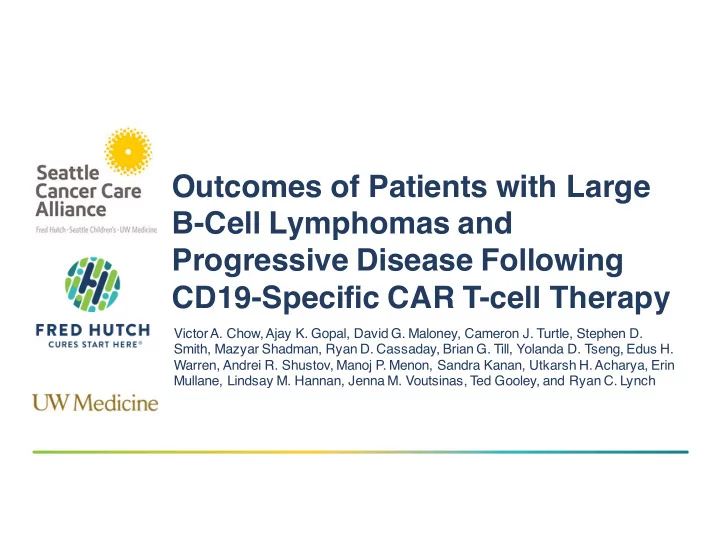

Outcomes of Patients with Large B-Cell Lymphomas and Progressive Disease Following CD19-Specific CAR T-cell Therapy Victor A. Chow, Ajay K. Gopal, David G. Maloney, Cameron J. Turtle, Stephen D. Smith, Mazyar Shadman, Ryan D. Cassaday, Brian G. Till, Yolanda D. Tseng, Edus H. Warren, Andrei R. Shustov, Manoj P. Menon, Sandra Kanan, Utkarsh H. Acharya, Erin Mullane, Lindsay M. Hannan, Jenna M. Voutsinas, Ted Gooley, and Ryan C. Lynch
Background CD19-specific CAR T-cell therapy (CART) is effective in patients with relapsed/refractory (R/R) large B-cell lymphomas. - Durable complete response (CR) rates of ~ 40% Patients generally do not experience prolonged disease control if they are unable to achieve a CR. Little data exists on outcomes of patients if they progress following CD19- specific CART.
Methods We identified patients at our institution who met the following criteria: 1) Developed progressive disease (PD) after CD19-specific CART 2) Did not receive any protocol-specified anti-lymphoma therapy after CART infusion 3) Treated for one of the following histologies: - Diffuse large B-cell lymphoma (DLBCL) - Transformed follicular lymphoma (tFL) - Primary mediastinal B-cell lymphoma (PMBCL) - High-grade B-cell lymphoma (HGBCL)
Methods Primary Analysis: Overall Survival (OS) after PD Secondary Analyses: OS based on the following characteristics 1) Timing of PD - Initial PD – progression on initial disease response assessment - Delayed PD – progression on subsequent disease response assessment 2) Use of bridging therapy – any anti-lymphoma therapy given between T-cell collection and CART 3) Ability to receive subsequent therapy after PD
Methods NOT INCLUDED IN THIS ANALYSIS: CART product and construct CART dose Lymphodepleting chemotherapy regimen Inflammatory markers Cytokine release syndrome Neurotoxicity Potential mechanism(s) of escape and progression
Results: Patient Characteristics TOTAL INITIAL PD DELAYED PD CHARACTERISTICS P value (N = 58) (N = 30) (N = 28) Median Age 60 (26 - 75) 58 (29 - 70) 60.5 (26 - 75) 0.251 Histology 0.536 DLBCL 34 (58.6%) 19 (63.3%) 15 (53.6%) HGBCL 12 (20.7%) 4 (13.3%) 8 (28.6%) PMBCL 3 (5.2%) 2 (6.7%) 1 (3.6%) tFL 9 (15.5%) 5 (16.7%) 4 (14.3%) IPI 0.358 0-1 12 (20.7%) 4 (13.3%) 8 (28.6%) 2-3 37 (63.8%) 21 (70.0%) 16 (57.1%) 4-5 9 (15.5%) 5 (16.7%) 4 (14.3%) Median LDH (pre-CART) 210 (111 - 2339) 250 (117 - 2339) 189 (111 - 691) 0.026
Poor OS after progressive disease Survival Probability MEDIAN = 5.3 MONTHS Time After Progression (months) Number at risk Strata
Initial PD is associated with inferior survival P = 0.038 Survival Probability Initial PD Delayed PD, N = 28 MEDIAN = 13.42 MONTHS Initial PD, N = 30 MEDIAN = 3.75 MONTHS Time After Progression (months) Number at risk
Results: Bridging Therapy TOTAL INITIAL PD DELAYED PD N = 20 (34.5%) N = 12 (40.0%) N = 8 (28.6%) Chemotherapy +/- steroids 9 (45.0%) 4 (33.3%) 5 (62.5%) Intrathecal chemotherapy 1 (5.0%) 0 (0.0%) 1 (12.5%) Novel/targeted agent +/- 5 (25.0%) 4 (33.3%) 1 (12.5%) steroids Steroids 5 (25.0%) 4 (33.3%) 1 (12.5%) BRIDGING THERAPY: Any anti-lymphoma therapy given between T-cell collection and CART
Impact of bridging therapy on survival P = 0.37 Survival Probability YES, N = 20 MEDIAN = 3.16 MONTHS NO, N = 38 MEDIAN = 7.14 MONTHS Time After Progression (months) Bridging Therapy Number at risk Time After Progression (months)
Impact of bridging therapy and type of progression on survival MEDIAN OS (MONTHS) No Bridging + Delayed PD 13.55 No Bridging & Bridging & No Bridging & Bridging & Delayed PD Initial PD Initial PD Delayed PD No Bridging + Initial PD 5.20 Survival Probability Bridging + Delayed PD 3.19 Bridging + Initial PD 2.34 P = 0.19 Time After Progression (months) Number at risk Time After Progression (months)
Impact of bridging therapy and type of progression on survival P = 0.059 Survival Probability Bridging & Delayed PD No Bridging + Delayed PD, N = 20 MEDIAN = 13.55 MONTHS Other N = MEDIAN = 3.55 MONTHS 38 Time After Progression (months) Number at risk
Next treatment after progression 44 (76%) patients received ≥ 1 INITIAL SUBSEQUENT TOTAL subsequent therapies after PD. THERAPY (N = 44) CAR T-CELL 14 Patients receiving ≥ 1 subsequent therapies after PD had a lower risk of NOVEL THERAPY 13 death, compared to those who did not. CHEMOTHERAPY +/- R 7 • HR 0.48, 95% CI 0.234-0.99, P = 0.0476 ANTI-PD1 INHIBITOR 4 6 (10%) patients enrolled onto a clinical RADIOTHERAPY 4 trial as next line therapy. INTRATHECAL 1 5 (9%) patients eventually received an ALLOGENEIC HSCT 1 allogeneic HSCT, 2 of whom are still alive.
Conclusions Patients with PD following CD19-specific CART have poor outcomes. Patients with initial PD had inferior overall survival. More effective strategies are needed to improve CR rates and prevent PD. Planning for the potential of PD following CART should figure into the treatment algorithm for R/R disease. These data set the stage for novel combinations in the future (eg bridging therapy, maintenance therapy). These data should inform clinical trial design.
Acknowledgments PATIENTS & FAMILIES LYMPHOMA & IMMUNOTHERAPY TEAMS RESEARCH & BIOSTASTISTICAL TEAMS FUNDING FROM 5K24CA184039, T32CA009515
Recommend
More recommend